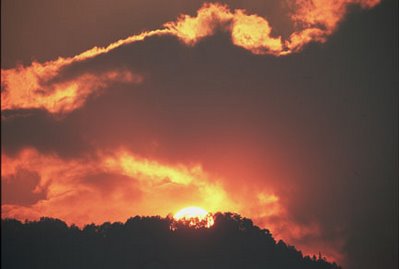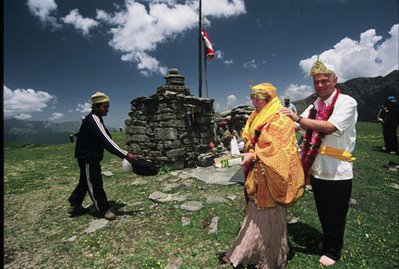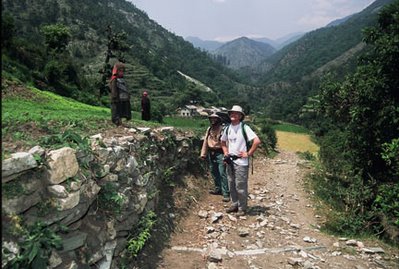
When a British couple expressed their desire to get married in one of the world’s largest and highest meadows, you can’t dismiss it as high altitude sickness. It stems from something more; a serious malady called love. It was certainly the strangest request we had ever received. We prided ourselves in our ability to customize a tour to the liking of our clients but this was truly unusual. Couples have done it underwater, in outer space, even mid-air while skydiving but whoever heard of getting married on a trek!
It wasn’t a request you could politely turn down, as this was Mark’s third trip with Wild World India. Having grown up on legendary tales of British adventurers Shipton & Tillman (the first to scale Nanda Devi), Mark harboured the romantic notion of getting married on the Tillman’s trail. It was easier to get him married in Joshimath, where matrimonial trappings were easily available or at Wan, where he just had to go around a temple to be married, without the help of a priest. But having spent enough time in India, Mark was well versed with Indian traditions. He wanted an authentic Hindu wedding, a grand affair that ranked midway between a gandharva vivah and an ashwamedha yagna – with true-blood pahari musicians, a pandit to chant the Sanskrit shlokas, a menhdi artist for the bride, a cook who could easily switch between pasta and paalak and a professional photographer to capture every single frame of this epic tale. In an earlier trip Mark got engaged at the Ganesh temple inside the 1000-year-old Ranthambhore fort.
A fortnight before the couple flew into Delhi; Chief Naturalist of Wild World India Sumantha Ghosh did an extensive reconnaissance trip to Bedni. Ghosh’s first job was to assemble his crew. The keyword was fitness. If the priest fumbled on his mantras but didn’t stumble on his step, he was in. Since it was the marriage season in the mountains, two priests were sourced with great difficulty from the Sanskrit Academy in Ramnagar. They were quite fit, for each had to carry 20 kg sacks of sacred knickknacks including 3-4 sacred brass bells of varying sizes. Four local village musicians were sourced from Loharjung Pass, the base-camp of the trek. With a dhol, a small percussion instrument, a bagpipe and a local clarinet, the Bedni Quartet was complete. Devender, the regular excursion cook was an expert who could easily stir up a 4-course meal. A local tracker, two porters and 4 horses were kept on standby to carry kerosene, stoves, camping equipment, kitchen tent, luggage, toilet tent and provisions for the 21-day trek.

With the tough part out of the way, Ghosh was onto his next step – actually doing the trek to figure out the lay of the land, proximity to a water source, vantage points for romantic stopovers and nitty-gritties like which way the bride’s tent should face. Gauri, the soft-spoken fleet-footed mountain man who led most trekking expeditions for Wild World India, accompanied Ghosh. Together, they did the trek in seven days and returned to Delhi with just enough time to finalize the photographer. By the end of Ghosh’s lengthy discourse on ‘Once-in-a-lifetime-opportunities’ and lured by the untold magic of Bedni, Prithvi Gill agreed. With 4 cameras and as many lenses, it amounted to 35-40 kg for his porter, plus 20 kg for himself. Two days later, with heaving breaths and big smiles pasted on their faces, Ghosh and Gauri received Mark and Liz at the airport. The mad marriage was on.
After the overnight train-ride to Ramnagar, it was a further 10-hour drive to Loharjung, from where Tapovan (the end of the trail) was 125 km. Since it wasn’t the distance but the altitude you covered in a day that mattered, the team stayed the night at Loharjung to acclimatize and started next morning after an early breakfast.

The first leg was a 5-hour trek that led down into the temperate forests of the Gyan Ganga Valley, across the river and uphill above the small village of Didana where they set up camp. The second day was far more grueling. The altitudinal gain of 2000m took the team right above the tree line, where the air got thinner and everyone could feel its dehydrating effect. As they approached Bedni Pass, a sudden hailstorm enveloped them. It snowed heavily; the temperature plummeted to sub-zero and the lashing wind turned more hostile. Luckily, the group made it to the log hut before dark. It was the night before marriage. While the eggs boiled, the menhdi paste was prepared. In the mountains, they apply menhdi even to the bridegroom. In accordance to strict Hindu traditions the couple was politely asked to stay apart till the next morning.

Next day – through some cosmic intervention – the weather just opened up, like the gods knew of the impending marriage. The group unzipped their tents, only to be stunned by a glimpse of the Chaukhamba (23,555ft), Nilkanth (21,766ft) and the majestic Nanda Ghunti that loomed in front. As the sun came up, the snow began to melt and drained off the slopes like raindrops bouncing off a lotus leaf. The ground seemed like a lush green carpet sequined with yellow and purple flowers. While the wedding was on, a huge flock of sheep gatecrashed the venue, accompanied by mountain horses and bhotiya dogs – like a huge marriage procession. At 11,000 ft, it did seem that marriages are indeed made in heaven.

The ceremony took place at the Nanda Devi temple. It’s alleged that eons ago Lord Shiva and Parvati got married at this very place. Out of sheer reverence or perhaps due to the fact that the place was so far flung, no one had got married here ever since. Strange as it sounded, after Shiva and Parvati ¬– right on the other end of the pigment spectrum – it was Mark and Liz. Just so that no feathers were ruffled, two priests came from Wan and oversaw the sacred thread ritual as part of Mark’s purification rites. Then came the problem of who’d give away the bride. Before an emotional Ghosh could find his voice, Gauri answered the priest that he was older and hence became Liz’s makeshift brother. Ghosh had to make do with being Mark’s best man.

The marriage ceremony lasted three hours. To maintain the sanctity of the temple, no non-veg was allowed, so the wedding feast was purely vegetarian – poori-alu, chholey and halwa. Some 30 guests came for the feast – local villagers, bhotiya tribesmen, Austrian and Danish trekkers. After the feast, there was a dance party and Mark’s only bottle of Glennfiddich was doled out in wartime ration amounts. The words of Bill Tilman rang true – “We live in an age of mechanization and in recent years it has become apparent that even mountaineering is in danger of becoming mechanized. It is therefore pleasing to record that in climbing Nanda Devi, no climbing aids were used, apart, that is, from the apricot brandy we took.” In sharp contrast, the trekking party had to make do with some atrocious hooch made from fermented rice and sheep meat, supplied by Golmaal, the caretaker of the small shack at Bedni.

The marriage euphoria lasted for a day and then it was back to regular trekking. The photographer, his porter, the pandits and the musicians returned from Bedni but Mark and Liz plodded on for two more weeks with the remaining skeletal team. After the first week the vegetables got over and they had to switch to tinned food like mushrooms, tuna and baked beans. Once some Bhotiyas sold an injured sheep (mauled by a leopard) for Rs.400. It was not lack of love but more a sense of reality that made them do so. But it meant a rare feast for the trekking party. At Bedni, they spotted the Himalayan Brown Bear, Himalayan Tahr, Yellow-throated Marten, Monal pheasants and the Himalayan Pika, a tame mouse hare that timidly peeped out of its burrow.

Though many trekked to Bedni Bugyal, few extended the trail to cover the Roop Kund and Kuari Pass treks in one go. The trail was partly on a centuries old pilgrim pathway that formed the Nanda Devi Raj jat yatra. After 21 days of trekking, the newly weds finally emerged at Joshimath. It was the sort of arduous journey that can break marriages, but in the case of this adventurous couple, it only strengthened the bond. Tired and weather-beaten, they drove in via Rishikesh to see the divine aarti at Har Ki Pauri in the evening and finally returned to Delhi heading straight from the railway station to Vikram’s house. Liz kicked a kalash (sacred vase) of rice at his doorstep and completed the formality of the house-entering ceremony. There was just enough time for lunch and a farewell party before the couple caught their flight back to London. Strangely, no one had told Liz about the vidai ritual but by some acquired instinct she cried like she was leaving her family behind.

Bedni Bugyal: Treasure trove of natural wonders
Since the whole area is part of the Nanda Devi Biosphere Reserve, it is rich in Himalayan flora and fauna. One can see Pika, Red Fox, Himalayan Tahr, Yellow-throated Marten, Snowcock and Mrs Gould’s Sunbird while Lammergeyers and Himalayan Griffons silently glide in the skies above. At Bhagubasa, you can sometimes see pugmarks of the Snow Leopard. Seeing it is difficult, which has earned it the name The Grey Ghost of the Himalayas. Near Kuari Pass, you can see bharal (Blue Bull), Himalayan Black Bear and the multi-coloured Himalayan Monal, the state bird of Uttaranchal and Nepal’s national bird.
Wild World India’s pointers towards responsible tourism
• Since most of the treks to Bedni and beyond are largely unmonitored, it has led to irresponsible travel and the mountains are facing degradation in terms of garbage. Don’t just bring back your garbage but make it a point to pick the litter of the more careless travelers before you.
• On account of Bedni’s rich floral heritage, there has been illegal herbal extraction on a mass scale for commercial gain. Do not encourage removal of endemic herbs or flowers.
• The Himalayan Monal is a beautiful pheasant that is sometimes poached for its meat and its feathers, which are used as tufts for caps. However, the shimmering beauty of the highly endangered Monal is best appreciated in the wild. Respect the Himalayan fauna.

Pictures: Prithvi Gill
1 comment:
truly... marriages are made in heavens....
thanx... wildworldindia...
Post a Comment